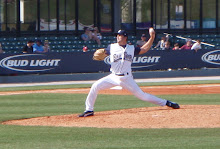Unfortunately, as hitters get older and better with strike-zone discipline, they become less and less likely to chase pitches that are not in the zone for very long. Aside from the occasional 'bad ball hitter' (think Pablo Sandoval or Vladimir Guerrero) most Big League hitters are trained to look for one pitch and one spot and not miss that pitch, fouling off or taking everything else. So somehow, the Intelligent Pitcher must find a way to get hitters to swing at pitches in the strike-zone and still miss-hit or whiff all together.
To win the battle versus hitters that have become more disciplined, the Intelligent Pitcher must make it impossible for the hitter to tell the difference between his straight fastball and any other pitch that he is throwing. He must repeat his delivery every time and release the ball from the same release point every time. This is especially important when switching from pitch to pitch. Whether you are throwing a fastball, change-up, curve, slider, or anything else for that matter, the most deceptive pitcher's arm speed must stay the same at all times and must release the ball in the same 'window.' To better visualize this, think about what a hitter sees when he's facing a pitcher. At release, the hitter is looking at one specific spot and tracks the ball all the way to the hitting zone. If he is unable to detect a different arm slot at release, he will be less likely to react correctly to the pitch.

Most hitters can't tell an RJ fastball from an RJ slider until its too late - notice the pictures (can u guess which is which)?

Also important is the path the pitch takes to the plate. It is necessary for most off-speed pitches to look like a fastball as long as possible, only deviating from that original path when it gets to the plate. The same reasoning applies here as before, the less time the hitter has to recognize that the pitch isn't a fastball, the less likely he will be able to put a good swing on the ball. For example, a good slider will look like a good inside fastball until it gets to the plate where it will dive down and in. A good change-up will look like a fastball away (usually) until it gets to plate where it will drop down or fade away from the hitter. Even a good sinking fastball will start up in the zone as if it were a good fastball to hit, only to "sink" at the last second. This is why most sinker ball pitchers are ground ball pitchers. Typically the hitter ends up making contact either on the end or handle of the bat - resulting in a weak grounder.

Fix it Peek!
ReplyDelete-Jake